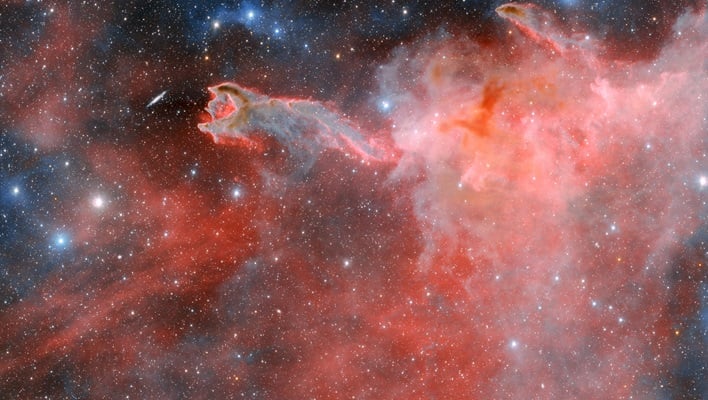
NOIRLab’s Dark Energy Camera (DECam) has captured some of this year’s most breathtaking images of deep space. From God’s Hand to stellar tendrils, the 570MP digital camera has left millions awe inspired. Here’s a round-up of these amazing stellar sights that have been discovered so far this year.
Dark Energy Camera
The Dark Energy Camera is part of the Dark Energy Survey (DES), which is an international collaboration which includes Fermi National Accelerator Laboratory, the National Center for Supercomputing Applications, and NOIRLab. Its mission is to create a map that includes hundreds of millions of galaxies, detect thousands of supernovae, and to find patterns of cosmic structure that could reveal the nature of dark energy that is believed to be speeding up the expansion of the Universe.

DECam itself is a high-performance wide-field CCD imager mounted at the prime focus of the Victor M. Blanco 4-meter Telescope at Cerro Tolollo Inter-American Observatory. Along with 570 megapixels, it touts 62 science CCDs and 12 CCDs for guiding and focusing. DECam’s main purpose is for the Dark Energy Survey, which has gathered some of the most awe-inspiring images from deep in space this year.
Cometary Globule CG 4 (God’s Hand)
Cometary Globlue CG 4 was first photographed from the UK Schmidt Telescope in 1976. At that time it showed several objects resembling comets, which later became known as cometary globules because of the similarity in shape to comets.
Also known as ‘God’s Hand,’ CG 4 is only one of many cometary globules within the Milky Way galaxy. How these structures get their distinct shape is still a matter of debate among astronomers. The image above of CG 4 was captured by DECam on May 6, 2024.
CG 4 is a star-forming region located in the Puppis constellation, which lies approximately 1,300 light-years from Earth. The cometary globule has a dense head formed of gas and dust, which is about 1.5 light-years in diameter, and an elongated faint tail around 8 light-years in length.
Menagerie of Intertwined Galaxies And A Galactic Illusion
The next phenomenal image from the Dark Energy Camera is of a group of galaxies intertwined in a cosmic dance. Collectively known as RSCG 55, this intertwined group of galaxies, meaning they are located close enough to influence one another gravitationally, will greatly affect how each evolves over time. This could lead to distorted shapes, increased rates of star formation, and galactic mergers.
Astronomers and scientists believe that gravitational interactions between galaxies such as this have had a meaningful impact on the variety of galaxies they now observe in the Universe. The most evident example in this image, according to NOIRLab, is the well-defined tidal bridges, which appear as faint trails of material between the galaxies.
The image of the intertwined galaxies was only part of a larger image the Dark Energy Camera captured. The wider shot, seen below, captures both NGC 4410 (the intertwined galaxies in the image above), and NGC 4411. NGC 4411, toward the center of the image, comprises two companion galaxies NGC 4411a (right), and NGC 4411b (left), which appear in a deceptive union, or a galactic illusion.
While the two galaxies are believed to be right next to one another, both at a distance of 50 million light-years from Earth, they don’t show signs of interactions. If the two were interacting, NOIRLabs remarked they would appear intertwined, like NGC 4410.
Stellar Tendrils of the Vela Supernova Remnant
Next up on the list is a colorful web of wispy gas filaments, known as the Vela Supernova Remnant. This cosmic wonder is an expanding nebula of cosmic debris left over from a massive star that exploded around 11,000 years ago. The image was captured by the Dark Energy Camera on March 12, 2024.
NOIRLabs remarked the striking reds, yellows, and blues in the image were achieved through the use of three DECam filters. Each filter collected a specific color of light, churning out a separate image. The separate images taken in each filter were then stacked on top of each other to produce the high-resolution image that contains 1.3 gigapixels of data.
Supernova Remnant Puppis A
The last image from the DECam is of Puppis A, a supernova remnant that is about 100 light-years in diameter, and roughly 6500-7000 light-years away from Earth. Much like the image of the intertwined galaxies shown above, the image of Puppis A is part of a larger image. That being the 1.3 gigapixel image of the Vela Supernova Remnant.
Puppis A is one of the most studied objects in the sky. The bright supernova remnant is believed to have exploded about 4,000 years ago. A study conducted in 2007 using an image of Puppis A captured by the Chandra X-ray Observatory suggested the supernova explosion was lop-sided, kicking a neutron star in one direction, and most of the debris from the explosion in the other.
NOIRLab’s Dark Energy Camera has captured some impressive images during its lifetime, as you can see, so far in 2024. With another six months left in the year, we at HotHardware look forward to more tantalizing images to come.




